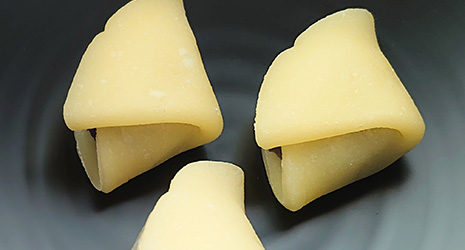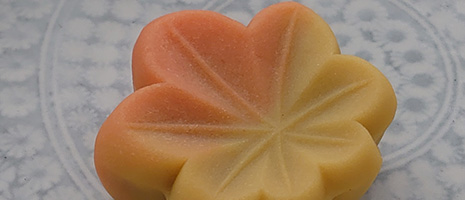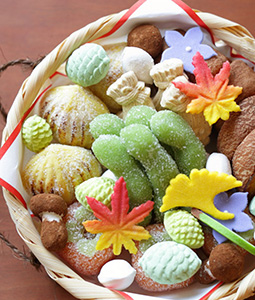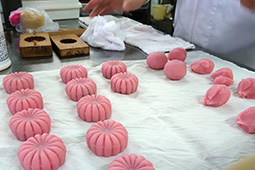INDEX
- English
- 日本語

Jo-namagashi (superior fresh sweets) in the autumnally-colored shape of three ginkgo leaves - English
- 日本語

A single Momiji, one of Kagizen Yoshifusa’s classic autumn wagashi, here announcing the maple leaves’ change in color from yellow to orange

Kagizen Yoshifusa’s autumnal higashi (dry sweets) assortment entitled Minori no aki (Autumn berries) 
A confectioner prepares a line of jo-namagashi sweets
September 2021
Autumn Wagashi Bring Color to Kyoto

Kyoto is one of Japan’s most celebrated places for colorful autumn foliage. Here, heartfelt love for these beautiful autumn colors has long been expressed in wagashi, traditional Japanese confectionery.

Japan has four distinct seasons and a culture has been developed that cherishes a sensibility to these. Wagashi (Japanese sweets) are a fine example of this tradition. Kyoto wagashi in particular, loved by court nobles and tea masters since ancient times and by writers and artists in the modern era and later also, have a long history of gradual refinement.
Confectionery store Onkashi Tsukasa Kagizen Yoshifusa has been making wagashi in Kyoto’s Gion district for around three hundred years. Imanishi Zenya, fifteenth generation head of the store, says, “We announce the coming season to our customers by incorporating small seasonal changes in our wagashi ahead of time.”
One of the store’s classic autumn wagashi is called Momiji (Japanese maple). Each day, the Momiji displayed in the window of the store gradually change color from yellow to red, just like the maple leaves, conveying to passersby the atmosphere of the autumn season as it gradually deepens.

This type of wagashi is known as jo-namagashi (superior fresh sweets). Hand-made by highly skilled confectioners, jo-namagashi are said to have originated in Kyoto in the early seventeenth century and eventually spread throughout Japan.
Jo-namagashi can be made to represent not only seasonal flowers, but also things such as seasonal scenes. This is achieved through the use of ingredients such as sweet red bean paste (anko) made by boiling and straining red azuki beans, colored dough made from white kidney beans or white azuki bean paste mixed with flour and other ingredients (konashi), and transparent agar made from seaweed. Chestnuts are another essential seasonal autumn ingredient. With sophisticated hand skills, wagashi confectioners use spatulas and other tools to shape these ingredients into maple leaves, for example, which are then colored to create beautiful and delectable sweets that are pleasing both to the eye and to the palate.
Namagashi contain a large amount of water. In contrast, dry wagashi contain just a small amount of water and are called higashi (dry sweets). Kyoto is home to a type of wagashi called oshimono or uchimono, which is made by placing sugar or rice flour into wooden molds and then knocking it out of the molds. Those made from wasanbon, Japanese sugar made from sugar cane in the traditional way, are considered to be the most luxurious. The wooden molds are made to create the forms of flora, fauna, and other natural phenomena characterizing the four seasons, and have been handed down from generation to generation in long-established wagashi stores—some at Kagizen Yoshifusa have been used for one or two centuries. The momiji maple leaf is one of the most popular autumnal designs for higashi, and features as the central motif in a design known as fukiyose that represents the colorful fallen leaves and nuts and berries blown by the wind. Stores in autumn are adorned with these fukiyose arrangements of higashi, which look like veritable jewel boxes. Recently, higashi have gained popularity among young people, who are finding that they go well with coffee.

Summer in Kyoto is hot, but once September has passed, the wind gradually turns autumnal as the city approaches the season of autumn colors. Autumn wagashi appear slightly earlier than the actual autumn colors, and so herald the coming season.

